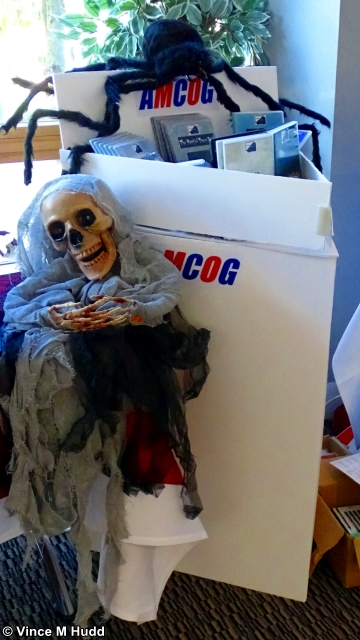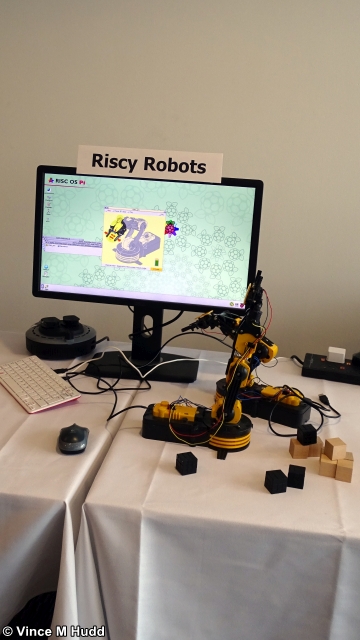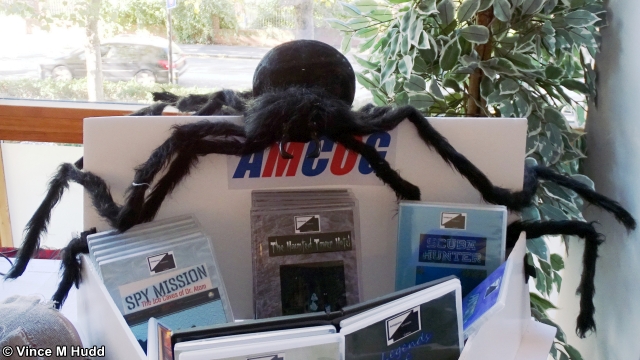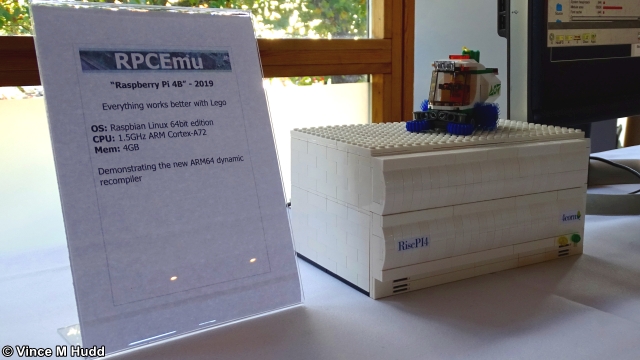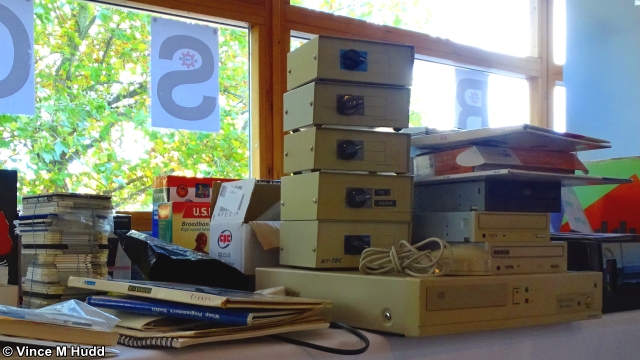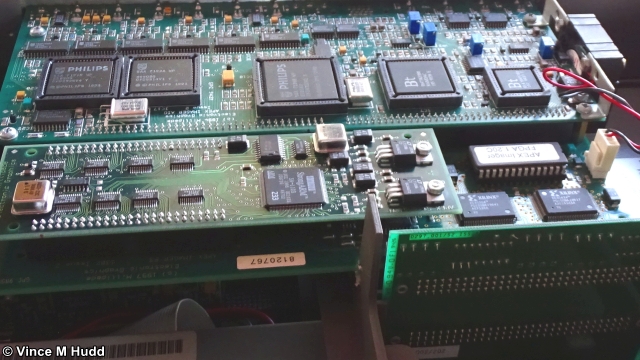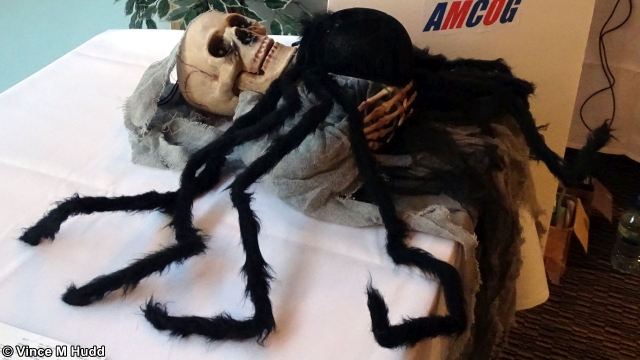30th October, 2021, marked the return to physical shows in the UK, when the RISC OS User Group of London (ROUGOL) hosted their customary October event at the St Giles Hotel in Feltham – the RISC OS London Show. Understandably under the circumstances, there were fewer exhibitors than in previous years, as well as few visitors; it was a much quieter show than usual – but despite that, it was still an excellent day for finding out what’s happening in the RISC OS world.
So what happened? What did we learn at the show? Read on and find out!
The show is normally laid out with exhibitors along both sides (and the very end) of the main room, with additional exhibitors taking up space in either or both of two side rooms, and a third side room used for the show theatre. With fewer exhibitors this time, those in the main room extended along only one side (and the end), with some also placed in just one of the side rooms.

ROUGOL
After venturing into show room and stumping up your crisp fiver, the first exhibitor to be found was ROUGOL – the show’s organisers.
The group meets every month on the third Monday with a presentation from a guest speaker – sometimes someone currently developing hardware or software for the platform, sometimes someone who has been a key player in the past, and sometimes someone from outside the more obvious RISC OS world, but who has something to talk about that would be interesting to us anyway.
And all of the talks I’ve seen – every single one since the group took the talks online because of the pandemic and consequent lockdowns, and one in person a year earlier – have been interesting and worth attending.
With the lifting of restrictions and physical meetings possible again, the group has recognised the benefits of holding meetings online for people (including potential speakers) who are a little too far away to make an in-person visit possible, and moving forwards intends to make their meetings hybrid, with some people meeting physically, and the rest online. To make that work, however, ROUGOL does need people who can attend in person to do so, in order to ensure the venue – the Duke of Sussex pub – keeps the room available to them. So if you can make it to a meeting, please get yourself down there.
Returning to the show, though, the group had a Raspberry Pi Zero 2W on their stand, running RISC OS. Members of the Zero series are smaller than a regular Pi, with fewer connectors – so they’ll fit in a smaller case (and space) but may need more effort to connect up; you’ll need a USB hub, for example, for a keyboard and mouse. The 2W is the latest in the series, so it’s pleasing to see that it was running RISC OS with no problem.
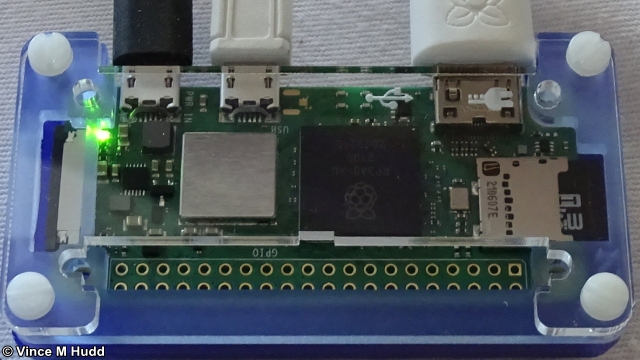
Also on display was another new Raspberry Pi board – the Compute Module 4 IO board – placed in a black, 3D-printed RiscPC-alike case.

Designed as a development platform/reference design, with a Raspberry Pi Compute Module 4 connected, the board effectively opens up the module, exposing all of its interfaces for physical connection.
RISCOSbits
After the host stand, Andy Marks was showing off his RISCOSbits range of cunningly named computers and cases – and talking about something new in the works.

The image above shows a selection of machines on offer – if I have this right, a Thorin Oaken Shield (bottom left) then standing like a row of dominoes, a Delta Compact cased machine, a PiAno, and a normal Delta. Not shown in that picture, though, is a FOURtress – the compact, Raspberry Pi-based machine was actually making its very first appearance at a physical show, meaning it was the first time I’d ever seen one in the flesh aluminium.

Although I knew the machine was small, until I saw it on the desk at London, I didn’t appreciate just how small – bearing in mind there’s more than just a Raspberry Pi in there, the thing is tiny, as you can see from that photo with a USB dongle sitting alongside it.
Andy had a range of limited edition FOURtress machines at the show, including the Lite and the Lite Plus, from which it’s possible to infer there’s less to them than the normal FOURtress, and thus dismiss with a wave of the hand the diminutive size. However, that’s the standard case – so even the normal version is that size!
Along with the pre-built machines, there were of course a selection of kits and cases to be had, with some limited runs especially for the show (and perhaps short period after – i.e. until they’re gone), such as a Delta XL oak and glass effect self-build machines, and Delta Compact cases.

Another new toy (newer than the FOURtress which, although new to shows, has been around since late 2020) that was available to buy was the EDOS400, with the ability to easily switch between RISC OS and Linux ‘at the click of an app’ as its main selling point, but there were also new works in progress, too.
One of these was an ‘exploratory LapDock device’ – a laptop dock for mobile devices, but one capable of doing proper justice to a Pi 4, with a 13.3 inch, 1920×1080 IPS display, a 360 degree hinge to allow use in tablet mode (though unfortunately the touchscreen doesn’t work with RISC OS).

The other work in progess – which sadly didn’t make it to the show – is a Mini ITX board, based on the Raspberry Pi Compute Module 4 Lite. The board can run a standard off-the shelf ROM build for the Pi (as found on the RISC OS Open Ltd downloads), and there is (or was at the time of the show?) still work being done to take advantage of some of the board’s enhanced features from RISC OS).
Archive Magazine
Although we often see Archive magazine at shows, the London Show welcomed it as a newcomer with its latest editor making his first appearance.

Gavin Smith took over Archive after Jim Nagel’s sad death in 2020, and embarked on a new volume to mark the new era of the magazine, with the latest issue appearing at the London Show – in fact, Gavin had arranged to have the magazines delivered straight from the printer to the venue!
Subscribers who attended the show were therefore able to pick up their copy of volume 25 issue 5 more or less hot off the press on the day – a 56 page issue featuring five pages of news, along with a number of feature articles and ongoing series – and non-subscribers had the opportunity to see what they were missing out on do the sensible thing, and sign up to start receiving the magazine in future.
Cameron Cawley
For RISC OS gamers, the first relevant port of call was Cameron Cawley’s stand. Part of the team that maintains ScummVM, a multi-platform application that allows a whole raft of point and click adventures to be played on modern systems including RISC OS, Cameron’s efforts in particular help ensure our OS is included in the list.

The full scope of the program has expanded since its first version, which acted as a virtual machine (the VM in its name) for games based on the Script Creation Utility for Magic Mansion (the Scumm in its name) used by LucasArts for a series of games, and it now supports a number of other game engines. In many cases, in order to run the games supported by the system you’ll need to own the originals – but in plenty of other cases, the games can be found online.
Cameron was also demonstrating another port, this time of a specific game – OpenSupaplex.
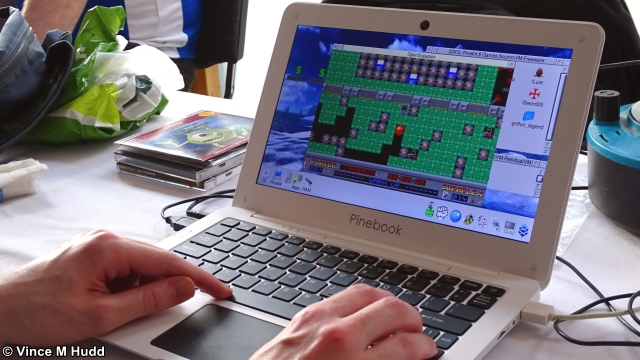
If you’ve read the 9th January Snippets Post) you’ll have heard of OpenSupaplex, but if not it’s an open source remake of Supaplex, which is itself a take on the Boulderdash idea. And if you aren’t familiar with Boulderdash, you will almost certainly have heard of Repton – a classic BBC and Electron game from Superior Software designed along similar lines, and another take on the same idea is a little something from Soft Rock Software called Drop Rock.
If you still need pointers, it’s a game in which you dig through the mud to collect all the crystals, being careful not to dislodge boulders that might block your way (or give you a massive headache) – unless you need to deliberately dislodge them to gain access to another part of the screen.
Well, Supaplex (and therefore OpenSupaplex) is something along those lines. And jolly good fun it is, too.
Soft Rock Software
Wearing my Soft Rock Software hat, this year I travelled a bit lighter than usual. Instead of bringing my usual kit – a Raspberry Pi, keyboard, mouse, and monitor, and a Windows laptop running VirtualRiscPC (as well as my background stand for posters etc.) – I brought just a couple of laptops, which had one game running on each, and my stock to not sell very much of.

One of the laptops was running the game I (sort of re-)released earlier in the year – Escape from Exeria. The first Archimedes version was released over thirty years ago, and pits you as a would-be escapee from the prison mines of Exeria, and you must navigate the many mazes, avoiding the patrolling guards and collecting the objects along the way, in order to find your way out.
The game was rewritten/improved in the mid-1990s to make better use of the RiscPC, and the new (sort of re-)release builds on that version with greatly improved graphics (now running at 1920×1080 in 16million colours), new sound effects, and twice as many levels to play (eighty in total) – with a new twist on the way the guards patrol on the extra levels.
The other laptop was running a new game released by Rick Murray, called Mamie Fletcher’s House. Developed in the run up to Halloween, in this game you take on the role of a teenage girl who sets out to prove that ghosts aren’t real by heading into a supposedly haunted house to take photographs of the so-called ghosts – except it turns out that ghosts are real, and the house really is haunted. Eek! Luckily, though, the camera flash can be used to despatch them.
The game features twenty two increasingly difficult levels (a number of which were designed by me – the reason I was demonstrating it), suitably spooky sound effects and a haunting theme tune.
Also available on my stand was the Soft Rock Software Collection on CD or USB Flash drive, and the remaining stock of RiscPiC cases.
AMCOG Games
Yet more games could be found on the next stand, belonging to AMCOG Games.
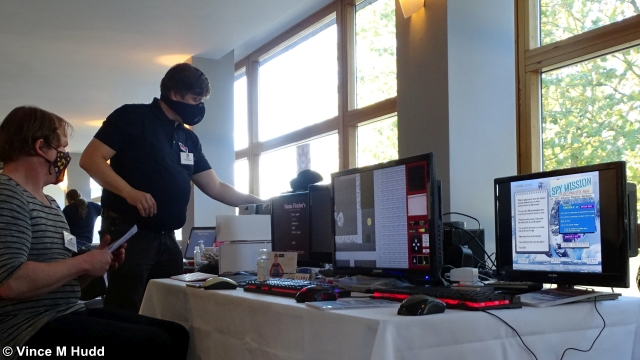
While I was running Mamie Fletcher’s House, Rick Murrays’s new game, because of my contribution to it, Tony Bartram was also running it on the AMCOG stand because he too had contributed to it. We’d both been play-testing the game during its development, and while I designed a number of levels for it, Tony’s direct contribution can be heard while the title screen and instructions are displayed – that haunting theme tune I mentioned.
And of course, in the run up to the show Tony had also produced yet another new title of his own – the Haunted Tower Hotel, which was also running on his stand, and available to buy. In this top-down arcade puzzle, you play a guest at the hotel of the title, and your goal is to leave, which is something the other, more supernatural residents would rather you didn’t.
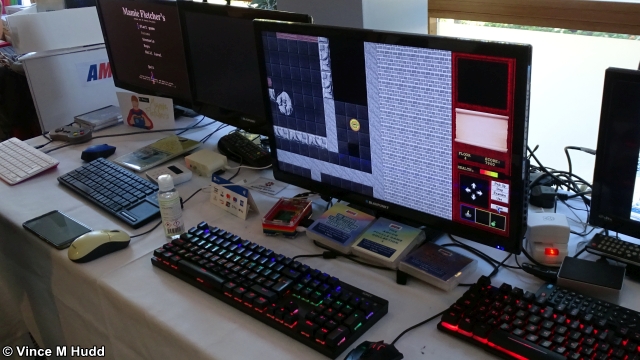
You therefore have to find your way to the ground floor, picking up objects that may be useful, and interacting with ghosts – some may actually be helpful, and some less so.
As well as the new games, Tony also had other titles from his range available to play and buy – and, in keeping with time of year, suitably spooky assistants.
RPCEmu
A new version of RPCEmu, the emulator that allows RISC OS to be used on Linux, Windows, and Apple computers, was released just in time for the show, and Peter and Matthew Howkins were present to show it off.

Version 0.9.4 saw some performance gains in the dynamic recompiler, and now allows ports to be forwarded between the host computer and the emulator, allowing the client OS to run servers such as WebJames. It can also now load HFE format floppy disc images, and if video RAM isn’t used then up to 4MB of main memory can be used for video modes.
The computer running RPCEmu this time around was a two-slice RiscPC… sorry, I meant a RiscPI4.
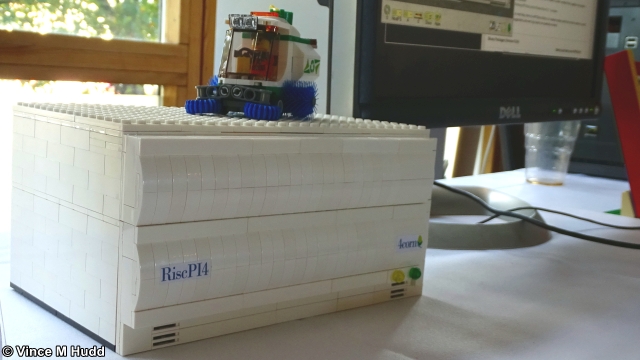
Made out of Lego (of course) and containing a Raspberry Pi 4B, the computer was running the 64bit edition of Raspbian Linux on its 1.5GHz CPU, and running on top of that was an ARM64 build of RPCEmu’s dynamic recompiler.
Charity Stand
An ever-present fixture of the main RISC OS shows is a stand devoted to selling old hardware, software, and publications to raise money for a good cause. For London, the supported charity is Combat Stress, which provides support for ex-servicemen/service women to deal with post-traumatic stress disorder, and other issues.

I haven’t been able to find out how much was taken by the stand this time around, though I have been told that the amount received a notable boost thanks to a very kind soul donating a Titanium machine on the day, approximately doubling the amount and making it the highest to date.

Acorn Preservation Project
After buying some software from the charity stand, a practical next stop might have been the Acorn Preservation Project, to get the contents of your newly acquired really old discs read and archived, preserving their contents into the future!

Paul Emerton was looking after the stand, where people were invited to bring old software discs to the show, and if the software wasn’t already present in the archive a preservation copy could be taken and the original discs returned. The goal is to ensure that there is as complete an archive as possible of all the software released for RISC OS (and other Acorn platforms) on disc – not just the main titles, but ideally each and every version.
One of the tools used to read old discs – which for various reasons may not be readable in old Acorn computers – is the Greaseweazle. This is a USB interface that allows discs to be read at a much lower level than would normally be possible using a standard floppy disc in a computer – which means it can help preserve the contents of discs that might not otherwise be readable. To that end, if you had a suitable device to store them on (ideally a USB flash drive or SD card with enough space – the resulting files can be quite large), copies of the images read by the set up could be given back to you to take home again.

Paul had also brought along some of his ex-BBC kit, previously used by the UK’s national broadcaster in the production of various TV shows, to add on-screen graphics where needed.
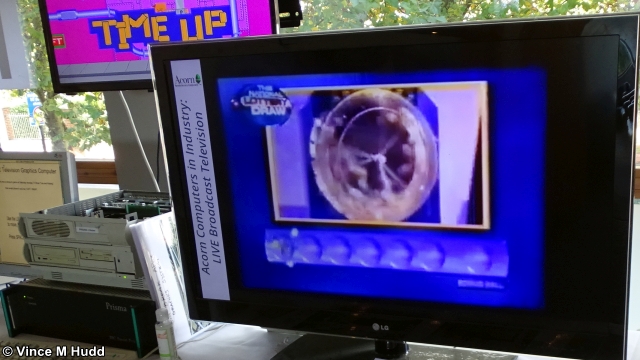
The equipment was obtained from the BBC Special Projects Unit, and Paul has been able to restore it all and recover the relevant software in order to show us how it was used.
Elesar
I mentioned a Titanium motherboard being donated to the charity stand, and the company behind all Titanium motherboards was the next exhibitor – Elesar Ltd – where Rob Sprowson was showing off not only the board, but also the company’s other varied products.

Other hardware includes a Wi-Fi solution for Raspberry Pi-based platforms. The Wi-Fi HAT complies with a Raspberry Pi standard called ‘Hardware Attached on Top’ (HAT) and provides the necessary and software that allows RISC OS, running on the Pi, to access Wi-Fi networks.
Software available from the company includes home-grown titles such as CloudFS, which gives RISC OS access to a cloud storage solution, but also packages that Rob has been able to take over maintenance and development of after the companies that were originally responsible for them have moved on. These include things like Prophet, a very popular accounts package, and publishing suite TextEase Studio.

North One Communications (Organizer)
This would be a good point for a crafty diversion, so nipping into the one side room being used to host exhibitors, the next stand belonged to North One Communications, purveyors of Organizer, the – no THE – personal information manager for RISC OS.

The latest version of the electronic filofax is 2.29, and it was available to buy as usual, with the Dibbler edition available to take away at the show – that’s the version supplied on a USB flash drive with RPCEmu (i.e. Organizer-on-a-stick), so that you can run it on any available PC when away from your own machine.
Ideas were also being sought by Nigel – and presumably from Martin Avison, the developer, who was also floating around the show – for future versions.
Drag ‘n Drop
On-off-on-off-under-new-management PDF magazine Drag ‘n Drop could be found on the next stand, manned by second (and by far the longest) editor Christopher Dewhurst.

As usual, visitors could buy the latest issue of the magazine on a USB flash drive along with an ever increasing amount of content in the form of all the back issues, making each new version increasingly good value.
Not stopping with the magazine, though, Chris has been building up a product line of publications – both printed and on CD, such as the latest title, The Application Tutorial and Listings Book, designed to help guide you through the process of writing desktop applications – all of which were available as well.
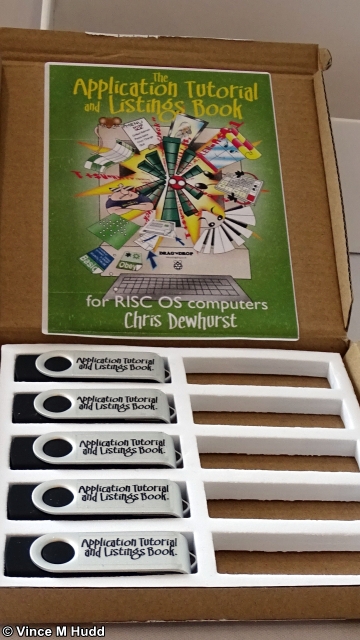
Chris Hall
The third exhibitor in the side room was Chris Hall, demonstrating a range of different items – both hardware and software.
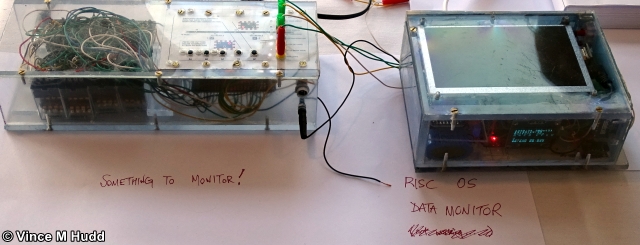
One of Chris’ projects – originally designed for use on the Severn Valley Railway, for which he volunteers – is a data monitor. With a host RISC OS computer running his software, various lines are fed out to whatever needs to be monitored, with the data received from those external sources recorded for later analysis. For the purposes of demonstrating it, Chris also put together a device to send signals to the computer, to emulate the systems that it would normally be watching.
Also on the stand was a modified version of the 4té computer from R-Comp. The machine is based around a Raspberry Pi running RISC OS Direct, housed in a 3D printed case produced by Wi-Fi Sheep’s Tom Williamson – and Chris’ modification adds a switch to the machine.

Given that there’s already a switch for power (on the right in the above photograph), the obvious question to ask is: What does it do? And the answer is to change the boot operating system of the machine. In Chris’ set up, with the switch to the left (recognising that the RISC OS Direct logo has the cog-half to the left) the machine boots into RISC OS, and with it to the right it will boot into whatever other operating system is installed.
Riscy Robots
The fourth and final side-room inhabitant was Neil Fazakerley and his army of robots; a selection of machines and devices, all controlled by computers – in this case running RISC OS, obviously – that bring an educational value to the show, by demonstrating how computers can be used to control systems and machinery, or – as with Chris Hall’s data monitor – record information from them.

The GYRO Cube pictured above is an example of the latter; picking it up and moving it around, the angle at which it is held – in all three dimensions – is tracked using a gyroscope attached to a Raspberry Pi inside of it, and that information is updated on the screen in real time.
A small array of other monitoring devices were also set up, each using a Raspberry Pi, and going the other way a robot arm was set up for visitors to play with, demonstrating how machinery could be controlled from the computer – and Neil was running a competition on the day; the best show of skill with the device could see the winner walking away with their very own kit. Neil told me later that rather than just one winner, in the end he chose two.

Orpheus Internet and RISC OS Developments
Back in the main room, Richard Brown and his daughter Serena were representing two companies – the most RISC OS friendly ISP, Orpheus, and the company Richard set up a few years ago with R-Comp’s Andrew Rawnsley initially to raise funds for the development of a web browser and act as the powerhouse behind its development, but which has since progressed to becoming a RISC OS powerhouse in more general.

As Orpheus Internet, Richard provides a range of services not only to RISC OS users, but anyone who wants a good, reliable, helpful, and friendly provider. The range covers not just ADSL and/or fibre connectivity, but also a range of hosting packages, and Richard is currently looking into a particular new service to add to the range – so keep an eye out for news of voice over IP telephone provision in the hopefully not too distant future.
As part of RISC OS Developments, Richard is providing a very important service to the RISC OS community as a whole – even to people who aren’t direct customers. The company was formed, as noted, with the ‘simple’ goal of raising money to fund development of a capable web browser, but has since grown beyond that initial remit – though the browser work continues apace.
While the browser itself, Iris, is not yet ready for general release, it is a demonstrably good piece of kit. Recent improvements and new features include tabbed browsing, including the ability to force new links to open in new tabs, a private browsing mode, a password manager and password auto-fill, an element inspector (handy for web developers) and much more.
This and some of RISC OS Developments other projects – including work on the new TCP/IP stack – were covered Richard’s talk in the show theatre.
Mentioned in passing in that talk was a program called Watermark, which was being demonstrated on the Orpheus/RISC OS Developments stand.

Written by Paul Reuvers, the program provides a neat way to add a watermark to another image, such as a small copyright notice. The program is better than that, though, and the watermark can be sourced from a Draw file, so it can be a logo for example, and provides options for how and where to add it. I don’t think it (yet) supports batch processing, but did suggest it to Serena for something to feed back to Paul. Hopefully, the program will become available in due course.
R-Comp
The next stand was R-Comp‘s, although the team manning the stand consisted of just Alan Wrigley and Andrew Pullan. Andrew Rawnsley was unable to make it in person because while the pandemic still presented a degree of risk the family remained in shielding (and given that the show organisers were subsequently notified that an attendee had tested positive for Covid-19, it was clearly a wise choice).
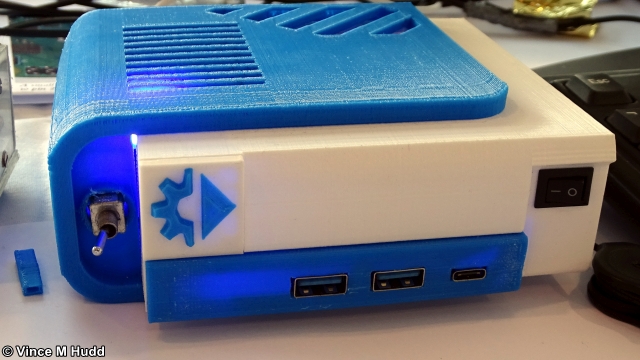
However, not being physically present, isn’t the same as not being present, and show visitors were treated to a talk by Andrew, courtesy of the internet and Zoom.
A number of topics were covered, starting with the Plus One, a hardware expansion board for the Raspberry Pi 400 which offers a hardware switch to change the booted operating system, and a real time clock. The unit is named as a nod to the Plus 1 expansion for the Acorn Electron, as the Pi 400 is a small form-factor computer-keyboard.
As well as talking about recently updated software such as Fireworkz Pro, demonstrating its newer features and showing how another package, WebWorkz, can turn its files into HTML documents, Andrew also talked about R-Comp’s new Mini-ITX board design for the Raspberry Pi 4 Compute Module, using an image of it to show off its different features.
Aside: Prior to the show, I was aware of RISCOSbits working on such a design in partnership with another company, so when Andrew first mentioned this in his livestream chat a couple of nights earlier, I assumed R-Comp was the partner – but in fact these are two completely separate projects.
The demonstration part of the talk was running on a 4té machine – a recent addition to R-Comp’s range – which Andrew was accessing over a VNC connection (because, obviously, he needed to use a different platform for the Zoom session) and he showed off a couple of features of that, one of which was the VNC configuration window, a much nicer way to set it up than the normal method of editing a file. he also demonstrated loading the web browser 4téBrowse (built on Iris) from the built in turbodrive, which shaved a good ten seconds off loading it over SDFS.
And finally, after noting that he had received a software updated from Ben Avison for the Pinebook, which improves its SDIO performance and unlocks other features – though he doesn’t know yet when it will be available to end users – he showed off the Pinebook Pro running RISC OS. This is a faster machine than the original Pinebook, with a 14″ screen, and better keyboard – but at this stage, it’s still a work-in-progress.
RISC OS Open Ltd
The end of the main room at the London Show has become the normal home for RISC OS Open Ltd (ROOL).

As usual, there was a range of software (such as development tools), publications (user manuals), clothes, and other items available to purchase from the team – including, priced at a very generous £0.00, window stickers.
Steve Revill gave one of the day’s three talks, in which he began by mentioning that the company was now in its fifteenth year, before going all existential and asking ‘why are we here?’
Well, okay, not quite in that sense, but the slightly more fundamental and relevant question of why we attend the show, use RISC OS, etc. He then went on to answer that in the sense of RISC OS Open, it certainly isn’t for the money – they don’t take any; not only do all of the bounty funds ultimately end up in the hands of developers, but they even took a hit on that money being received by the company while they were VAT registered. Similarly, the money from the sales of NutPi and ePic has all gone to the developers and companies whose products are included on them – estimated at something like £21,000 in total to date.
Discussing the company’s purpose and desire to be open (as per the name, but more than just in the sense of the software) was a build up to unveiling their new official purpose statement, which is “Safeguarding the past, present, and future of RISC OS for everyone.”

He also talked about the company’s achievements in those fifteen years, such as instigating and delivering the move to open source, which started with the move to a shared source licence from Castle – if that hadn’t happened, not only would we not be where we are today as a community, but there’s a good chance RISC OS itself simply wouldn’t be around now in the way that it is.
Looking ahead, as well as nightly builds of RISC OS allowing those willing to install them to play with the bleeding edge developments, he’s hoping the next stable release will happen in the next twelve months, and suggested the ideal is one every couple of years. There should also be a new desktop theme appearing soon. (This was evident in the run up to the show, as well as on large screen and the new poster behind the stand).

Steve also explained the situation with the user guide – that previously the licence they had for the fonts used within it didn’t allow them to make it available as a PDF, but that CJE Micro’s had now kindly stepped in and funded the change to a more useful licence, allowing them to make the Guide available as a PDF download.
Educraft
While wandering around ignoring potential customers at the Soft Rock Software stand (I could have passed up my first million, doncherknow), I happened across a random Acorn Electron and some bits and pieces sitting on a table on their own.
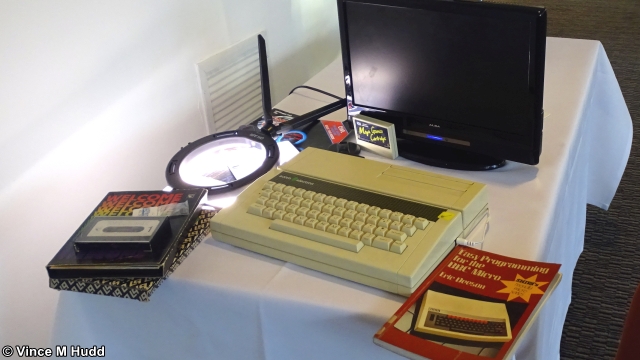
My assumption when I saw it was that it had probably been found by someone hidden away on the charity stand, promptly bought, and put to one side. It turns out that assumption was wrong – and the presence of what looks in the photo to be a ring light might have been a clue had I been paying attention.
In fact, there was an extra guest at the show; the Electron belonged to Educraft, an organisation that creates and provides workshops and lessons in various areas of computing. Not actually exhibiting, Alexandra from the organisation was there and interviewed ROUGOL’s Bryan Hogan (also a member of the Educraft team), Steve Revill from ROOL, and Chris Dewhurst from Drag ‘n Drop, and recorded an overview of Educraft’s Pixel Graphics & Animation workshop using that Electron.
Finally…
This was, as noted, the first proper – i.e. physical – show to take place in the UK since the pandemic landed on our shores, with the last one being Southwest 2020. It was good to be able to once again meet up with friends in the RISC OS world – whether users or other developers, both in the context of the show and after hours over a drink and a meal – to discuss what we’ve done, and what we have plans for, and so on.
So all that remains are the pictures I’ve not included in the main report, which can be found below – and to say that I’m looking forward to the next show; Wakefield 2022. See you there!






